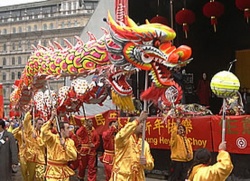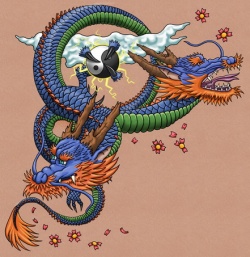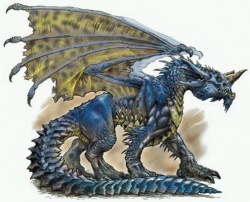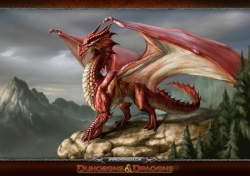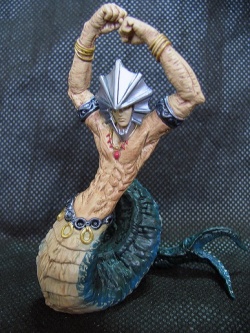The dragon invades the west
<poem> CHAPTER ELEVEN
THE DRAGON INVADES THE WEST
AN ENTIRELY new field of research lies before us in the West--in Europe. There the word 'dragon' is as familiar as in China, but its form and connotations are decidedly different. Certainly civilization began much farther back in time in Egypt and Iraq, India and China, and the object of our curiosity took form in the Orient long before its image appeared in the West, but was it invented anew in Europe, or was it brought in? If imported, whence? and how?
The earliest traces of European civilization belong to Greece, and the oldest indication of the Mediterranean man's thoughts about great mysteries is given in the hero-tales that have come down to us from that history-laden peninsula and its islands. These ancient and cloudy myths imply that "in those days" the earth was possessed by a race of Titans, giants huge and fierce, whose bodies below the waist were supported by a pair of thick serpent-tails instead of legs, reminding us of those pictures of mythical forerunners of Chinese tribes engraved on the tombs of the ancestors of the Wu family in Shantung; and the Titans' wives were the Lamiae--abominable hags. The chief God of that time was Ophion, the Great Snake; and it is difficult in studying these primitive fables to distinguish between the 'giants' of some stories and the 'dragons' of others: they seem to be the same. It was the task of newcomers, heroes bringing foreign gods, to conquer the giants and to enthrone on Olympus wholly human figures of power in place of the monstrous Ophion and his reptilian hosts. Saturn and Neptune (himself half man, half fish), and after them Zeus the sky-god, struggled for mastery of the world, and famous deeds against giants and dragons were performed by the Olympian heroes before Greece was rid of them.
Now, if all this ophidian prehistory was an original conception of the primitive inhabitants of eastern Greece, where the incidents seem to have been laid, and was remembered in tradition and folklore down to the time of Homer, the fact is remarkable, because no real serpent exists on the coasts or islands of the Agean Sea, or on the mainland of Greece, that has large size or would inspire either fear or respect worth mention. The only venomous snake thereabout is the small viper common all over the warmer half of Europe. Are we not, rather, considering dim, distorted recollections Of serpent-worshipping aborigines, for whom, if needed, there had been no lack of teachers during unnumbered previous centuries? Long before the days of Homer and Hesiod, or of the annalists and singers of Palestine, Egyptian and Syrian navigators were sailing about the Aegean Sea and between India and Egypt. They brought ideas from the East as well as goods. Nomadic 'Aryan' tribes were migrating with their flocks back and forth, as the seasons and pasturage changed, all over the plains between Thessaly and the highlands of Scythia and far Bactria. When they met other migrants and related tales of scenes and adventures in far countries, they told of strange gods and demons--half-human serpents often gigantic and terrible. With the dramatic sense strong in all primitive story-tellers, they garnished their reports with marvels undreamed-of by their listeners, and to be effectively enlarged when retold by the shepherds and fishermen of Macedonia, or among the Attic hills, or in the 'isles of Greece.' From such narratives, probably "all made out of the carver's brain," were developed the queer and often horrid conceptions that took shape in the mythology of almost prehistoric Greece, and afterward these were seized upon as 'material' in symbolic art and epic poetry.
The oldest definite traces of the dragon in Europe are in the Greek legend, preserved by Homer and Hesiod, of Cadmus and his band of adventurers--probably some long-remembered incursion of raiders from the eastward; and, judging by his fancied presentment on a vase exhumed at Palermo, he was a wholly human warrior, and not at all like Cecrops, the mythical founder of Athens, a being whose body terminated in the shape of a fat and scaly serpent. As Seiffert condenses the legend, Cadmus, having been led by a magic cow to a spot in Boeotia where he was thus impelled to plant his intended colony, proposed to dedicate the site at once by the sacrifice of a (or perhaps the) cow--a distinctly Aryan proceeding. Therefore he sent his companions for the necessary pure water to a near-by spring, where all were immediately slain by a huge serpent, the dragon-guard of the fountain. This incident is quite in accord with Asiatic ideas of the time regarding dragon-serpents' functions. As soon as Cadmus learned of the slaughter of his comrades he rushed to the spring and killed the dragon; then, at the command of an invisible voice (some say of Athene), he drew out its teeth and 'sowed' them over the adjacent ground. A host of armed men immediately sprang up, each from one of the broadcast teeth, who instantly began to fight and slay one another until only five remained alive. These survivors then quieted their fury and helped Cadmus build a stronghold, which finally developed into the city of Thebes. The five naturally became the ancestors of the Theban aristocracy, and one of them, Echion, called 'the serpent's son,' married Cadmus's daughter Agave. After many troubles King Cadmus retired to Illyria, where at last he and his wife Harmonia were changed into snakes, died, and were carried by the gods to the place of the blest. This denouement is very inconsistent, but it shows how the "trail of the serpent" lies over every incident and fancy in that fantastic infancy-story of Hellas.
One cannot gather from the writings of the early poets and chroniclers any distinct idea of the traditional or supposed appearance of the monsters with which the sun-gods were incessantly battling, except that whenever a chance glimpse is permitted one sees the serpent-likeness. Such was Python, half man, half snake, as some say, which haunted the caves on Mt. Parnassus, particularly that cleft in the rocks, originally called Pytho, where afterward was established the Delphic oracle. Apollo seized the place just after his birth, slaying Python with the first arrows from his infant bow; and in later times a festival was held there every year at which the whole story was represented in pageantry--the prototype of similar historic festivals celebrated during the Middle Ages in Europe and not yet quite obsolete.
Python was one of the offspring of Typhoeus and Echidna, themselves apparently son and daughter of Tartarus (underworld) and Gaea (earth). Echidna was part woman and part snake, and her brother-husband is identified with the Typhon of Egyptian mythology, otherwise Apop, one of the forms of wicked Set and a sort of duplicate of the Persian Azhi-Zohak, since he also is a gigantic demon, and has snakes sprouting from his shoulders. This diabolical pair further afflicted the world by engendering, in addition to Python, the three-headed dogs Orthos and Cerberus, the lion of Namaea, the Lernean hydra, the guardians of the orchards of Hesperus and of the Golden Fleece in Colchis, and perhaps other monsters of fable.
The most notable, perhaps, of this horrid brood was Hydra, a water-fiend that infested the region about Lake Lerna, near Argos, where it devastated the country of cattle and sheep, and whose breath even was a deadly poison. All accounts agree that it was an enormous water-snake with many heads--a hundred according to Diodorus, fifty says Eumenides, but the accepted opinion is that its heads numbered nine, one of which was believed to be immortal. To destroy this dreadful creature was thought worthy to be one of a dozen or so 'labours' assigned to Heracles (as tests of manhood?) by the Delphic oracle; and it was the only feat of the lot that he could not accomplish without help, because whenever one of the hydra's heads had been amputated two new ones would sprout in its place unless the wound were scarified by fire. Having scared the hydra out of its lair among the reeds by shooting at it fiery arrows, Heracles hewed at its heads, and as fast as he cut them off his nephew and charioteer, Iolaus, seared the bleeding stumps with a burning-iron. The hydra having at last been totally decapitated, the heroes piled a huge stone on its 'immortal' head and so prevented resuscitation of the evil.
A later and lesser sort of hydra was the chimaera, of which we may read in the Iliad, and which appears on the monuments "with the body of a serpent terminating in a head, and having two other heads as well, one a lion's in the usual place, the other a goat's rising out of the centre of the body. No one could overcome the chimaera, and it caused the death of many men by the fire it exhaled, until at last Bellerophon slew it."
The hydra seems to me a mere extravagance of the serpent-cult, not at all different from the Hindoos' many-headed nagas, and probably akin to them in history. Again, is the chimaera anything but a caricature of Marduk's sea-goat? The inference seems irresistible that the religious notions of the aborigines of Macedonia and prehistoric Greece were derived from India, by way of the wandering 'Aryans' of Thrace and the northern plains, tinctured with somewhat of the mythology of Egypt and Chaldea.
It has been said that the hydra was copied from the poulpe, or octopus, which infests the rocky shores and shallows of the eastern Mediterranean, but this seems to me improbable, however much the octopus may be recognized in certain other aspects of the myths and conventional designs characteristic of the Mediterranean region. More logically this repulsive cephalopod might well be regarded as the parent of the marine monster Scylla, finally exterminated by Heracles. She is described by Homer as dwelling on a tall rock in the sea where the lower half of her body is concealed in a cavern, whence she reaches out six long necks, each bearing a horrid head with three rows of teeth closely set (like the suckers of the cuttle), by which she catches fishes and other marine creatures, and snatches men off passing ships. (In later times she personified one of the two great perils in the navigation of the Strait of Messina.)
It is needless to catalogue all the misshapen and fearful monsters recorded in the legends found in the writings of Homer and Hesiod, and revived by Ovid and the later poets and artists of Greece and Rome. Heracles, Perseus, Theseus and other heroes arose to kill them off when a developing civilization and humourous skepticism required their extinction. Meleager freed the peasantry from the ravages of a gigantic boar. Heracles slew the huge Nemaean lion, dispersed the man-eating Stymphalian birds, and overcame in amazing battles several giants, such as Cacus and the river-god Achelous, who nearly escaped by transforming himself into a snake; and captured the Island of the Hesperides from the hundred-headed serpent Ladon, protector of the golden apples that Gaea had cultivated as a wedding gift for Hera when Zeus should marry her in this garden of the gods. Ladon, expelled from earth, was set up in the sky by Juno as the constellation known to us as The Serpent. Extremely ancient is the tale of the Argonauts, which has so many features in common with that of Cadmus, and records Jason's final achievement of their purpose by vanquishing the dragon that held the post of custodian of the coveted golden fleece, and who was the last of the progeny of Echidna and Typhon. Finally Perseus, by conquering a prodigious sea-serpent, rescued the forlorn but interesting maid Andromeda, and thereby became the remotest ancestor of all the redoubtable 'Saint-Georees' whose adventures are in store for us. Trail of the serpent again!
Perseus became the son of Zeus and Danae, after Zeus had visited her in the guise of a shower of gold poured into her lap. He had many adventures, including the killing of Medusa, the chief of the snaky-locked Gorgons, but the heroic incident that interests us most is his saving of Andromeda. This unhappy maid was a daughter of Cepheus and Cassiopeia. Cassiopeia had boasted herself fairer than the Nereids, whereupon Poseidon, the sea-god, to punish this profanity, sent a flood to overwhelm the land and a sea-monster to consume the people. The oracle of Ammon promised riddance of the plague should Andromeda be thrown to the monster (represented in a sculpture of the classic period, preserved in the Capitoline Museum in Rome, as a big, pike-like fish); Cepheus therefore felt compelled to chain his daughter to a rock on the shore, convenient to the marine 'dragon' when the tide rose. In this distressful situation Perseus appears, full of gallantry, destroys the approaching monster, and having thus rescued her and freed the threatened country, obtained the girl as his wife. The legend of Heracles and Hesione is virtually the same.
These 'snake-stories' and other figments of the imagination of a rude and adventurous people would have been forotten long, long ago, had not their dramatic possibilities been seen and utilized by the early bards to enrich the more or less rhythmical stories they chanted in village huts and by the shepherds' camp-fire, not to mention their use by the early vase-painters. Considering these matters in his valuable treatise on modern Greek folklore, Mr. John C . Lawson has distinguished several kinds or classes of genii visible in the fables and folk-tales of the Hellenic people past and present.
The third class of genii [he remarks], is terrestrial, inhabiting mountains, rocks, caves, and other grim and desolate places. These genii are the most frequent of all, and are known as dragons. Not, of course, that all dragons are terrestrial; the dragon form has already been mentioned as among the forms proper to the genii of springs and wells. . . . The term drakos or drakontas indicates to the Greek peasant a monster of no more determinate shape than does 'dragon' among ourselves. The Greek word, however, . . . is often employed in a strict and narrow sense to denote a 'serpent' as distinguished from a small snake (phodi). On the other hand a Greek 'dragon' in the widest sense of the word is sometimes distinctly anthropomorphic in popular stories, and is made to boil kettles and drink coffee without any sense of impropriety. It is in fact only from the context of the story that it is possible to tell in what shape the dragon is imagined; in general it is neither flesh, fowl nor good red devil; heads and tails, wings and legs, teeth and talons, are assigned to it in any number and variety; it sleeps with its eyes open, and sees with them shut; it makes war on men and love to women; it roars or it sings; . . . it is the dragon above all other supernatural heings, who provides the wandering hero of the fairy-tales with befitting adventures and tests of prowess.
Now, a striking feature of this whole race of prehistoric Greek 'dragons' is that they have no lizard-like, four-footed body, no kindliness of disposition, and nothing to do with rainfall or productivity of the soil. The exception to complete dissimilarity with the Chinese variety is that some of them have the office of guardians of women and treasure. On the other hand these fierce and horrid 'Pelasgian' creatures of a lively imagination portray, far more evidently than do the Oriental 'dragons,' the fears and emotions of a people half-savage, it is true, yet possessed of an alertness of mind very different from the rather bovine and 'single-track' mentality of the Hindoos and Chinese. The varied personages and adventures of the Greek hero-stories appeal in one way or another to us as they did to the men of antiquity (and as the Oriental ones do not); and this must account both for their seizure and preservation for us by the poets and artists between us and them in time, and for their present power to move us as symbols of things we feel and understand, though long disregarded as facts. A similar quality of dramatic reality belongs to much of the Persian mythology, and this strengthens the theory that Greece derived these notions from the prehistoric men of central Asia overland, rather than from Asia Minor by way of the Aegean islands, or to any great extent from Egypt by way of Crete--the latter in later times the channel of an invigorating influence.
Yet one cannot be sure that the Egyptian demonology did not tincture the superstition of the earliest Greeks, for prehistoric sculptures exhumed in Crete show water-demons of queerly changed crocodilian aspect with strange mammalian heads, and distinctly four-legged, which might have served as prototypes of the forms later developed in western Europe.
The Hittites and Phoenicians do not appear to have had in their history or religion any proper dragons, for their fiendish Moloch was certainly not of that (Chaldean) race; hence nothing of the sort has been revealed in Carthage or in the remains of other Phoenician settlements on the shores of the Mediterranean.
All the foregoing matter is mythical or legendary. We get upon fairly firm ground of fact about fifteen centuries before the Christian era, when invaders from the north penetrated the Epirus, expelled or subdued the barbarous 'Pelasgians,' and established themselves as settlers and rulers. These conquerors, known henceforth as Achaeans, were Nordic tribes of somewhat superior physique and culture, speaking an Aryan dialect out of which the Greek language developed. With their advent the history of the country begins, and the aboriginal stories of dragons, giants, and incredible heroes fade rapidly into folklore and become merely literary and artistic materials. Camps and caves are replaced by substantial buildings, and these become improved into the splendid edifices of the Golden Age of Greek art. It is noteworthy at this point to remark that from the very beginning in megalithic or 'Mycaenian' structures the ornamentation of neither temples, official buildings, nor private houses had any suggestion of the ancient serpent-cult, unlike what has happened in China and Japan, where images of dragons and snakes meet the eye in every city and village and keep alive their sacred and symbolic significance. Even statuary and decorative designing among the Greeks almost completely ignored this temptingly useful material, evidently rejected on grounds of good taste because of the unpleasant suggestions involved in everything reptilian. The horrifying figures of the Laocoon form a notable exception, but there the terrible serpent is an image of a real snake, not one derived from a myth.
When, in its decadence, Greece sank into the Roman empire, its legends were absorbed along with its lands, but the Romans were a very hard-headed people (apart from their day-by-day watching for omens), and having thrown away long before such antique lumber as dragon-tales--if ever they had any--they were not inclined to adopt any new ones from a neighhour's garret, save as here and there a small and picturesque bit might be worth saving as a ‘museum-piece' of folklore or poetry. They still held to some relics of serpent worship, such as the attribution of snakes to Apollo and to Aesculapius, and their connection with the cult of the Lares, or household gods, under the impression that these house-haunting mouse-hunters were guardian spirits, whence images of them were hung up in shrines--for luck! But Lares were not dragons. The nearest approach to our subject appears to be the fable of the basilisk or cockatrice, and that I judge to be of Egyptian origin, and made up of travellers' tales about spitting vipers; at best this undesirable creature was nothing but a venomous serpent endowed with supernatural qualities.
That they knew in Rome what a proper dragon looked like is plain from the engravings that remain of the standard of one of the legions in the Roman army. The Rev. J. B. Deane, whose old book bears the appearance of patient care, assures his readers that at the time when Rome was growing up the warriors of the Persians, Scythians, Parthians, Assyrians, and even the Saxons, "had dragon standards"; he explains also, quoting Latin writers of the age of the Caesars, that in the army of Marcus Aurelius, and afterward, flag-like images woven into the shape of a traditional dragon, were carried by each of the ten companies (cohorts) in a regiment (legion), whose regimental standard represented an eagle. Later, the dragon emblem was taken from the regular army and, in its Parthian form, was adopted as the general standard for the Auxiliary Corps. Thus in time it became the ensign of the emperors of the West whose troops were wholly Auxiliaries; and in the painting in the Vatican depicting Constantine the Great announcing to his soldiers his conversion to Christianity, a buoyant image of a winged, four-footed, proper dragon is prominently displayed, floating from a lofty pike-head.
With the 'decline and fall' of Rome, then, knowledge of the dragon might have disappeared from the western world forever had it not been revived at the last gasp, as it were, in the interest of Christianity and in the person of His Eminence the Devil.

